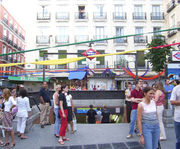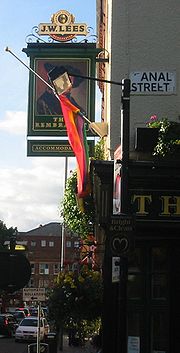- Gay village
-
 Straßenschmuck im Lesben- und Schwulenviertel von Chicago, mit der Regenbogenfahne als Identifikationselement
Straßenschmuck im Lesben- und Schwulenviertel von Chicago, mit der Regenbogenfahne als IdentifikationselementAls Lesben- und Schwulenviertel (auch Schwulenviertel; engl.: gay neighborhood, gay village) werden Stadtviertel bezeichnet, die sich durch eine ausgeprägte lesbisch-schwule Subkultur auszeichnen. Typisch sind ein hoher schwuler und lesbischer Bevölkerungsanteil sowie eine auf diese Gruppen ausgerichtete Infrastruktur, wie beispielsweise Bars, Kneipen, Nachtclubs, Saunen, Restaurants, Vereinsräume, Beratungszentren, Buchhandlungen und Videotheken. [1] In der wissenschaftlichen Forschung werden Lesben- und Schwulenviertel insbesondere in Queer Studies und Stadtforschung thematisiert.
Inhaltsverzeichnis
Geschichte
Lesben- und Schwulenviertel wurden in den westlichen Industriestaaten in der zweiten Hälfte des 20. Jahrhunderts sichtbar und selbstbewusst, entstanden jedoch Jahrzehnte vorher. Vor der Lesben- und Schwulenbewegung waren solche Gebiete kaum sichtbar, oftmals wegen der strafrechtlichen Situation, richteten sich jedoch in Nischen von Großstädten ein. So berichtet der Historiker George Chauncey von der Bowery als eine solche Nische in New York City um die Wende vom 19. zum 20. Jahrhundert, die bis zu den 1920er Jahren durch Harlem und Greenwich Village ersetzt wurde.[2] Auch Marc Stein sagt über Philadelphia aus, dass es Konzentrationen sowohl von Lesben als auch von Schwulen in den 1940ern, -50ern, und -60ern gegeben hat, die zum Teil überlappend waren, und sowohl Wohnraum, kommerzieller Raum, als auch öffentlicher Raum umfassten.[3]
Literatur
- Castells, Manuel, 1983, The City and the Grassroots: A Cross-Cultural Theory of Urban Social Movements Berkeley, Los Angeles: University of California Press
- D’Emilio, John, 1992, Making Trouble: Essays on Gay History, Politics, and the University New York, London: Routledge
- Escoffier, Jeffrey, 1998, American Homo: Community and Perversity, Berkeley, Los Angeles, London: University of California Press
- Florida, Richard, 2002, The Rise of the Creative Class: And How It's Transforming Work, Leisure, Community und Everyday Life, New York: Perseus Books Group
- Forest, Benjamin, 1995, West Hollywood as Symbol: The Significance of Place in the Construction of a Gay Identity, Environment and Planning D: Society and Space, 13: 133–157
- Kenney, Moira Rachel, 1998, Remember, Stonewall was a Riot: Understanding Gay and Lesbian Experience in the City Kapitel 5, Seiten 120–132 in: Leoni Sandercock (Editor), Making the Invisible Visible, Berkeley, Los Angeles, London: University of California Press
- Lauria, Mickey und Lawrence Knopp, 1985, Toward an Analysis of the Role of Gay Communities in the Urban Renaissance, Urban Geography, 6(2): 152–169
- Levine, Martin P., 1979, Gay Ghetto, Seiten 182–204 in: Martin Levine (Editor), Gay Men: The Sociology of Male Homosexuality, New York, Hagerstown, San Francisco, London: Harper & Row
- Ray, Brian und Damaris Rose, 2000, Cities of the Everyday: Socio-Spatial Perspectives on Gender, Difference, and Diversity, Seiten 507–512 in: Trudi Bunting and Pierre Filion (Editors) Canadian Cities in Transition: The Twenty-First Century, 2. Ausgabe, Oxford: Oxford University Press
Weblinks
Quellen
- ↑ M. P. Levine (1979) Gay Ghetto. In: Journal of Homosexuality 4(4), S. 364
- ↑ George Chauncey, Gay New York: Gender, Urban Culture, and the Making of the Gay World, Basic Books:New York, 1994, S. 227.
- ↑ Marc Stein, City of Brotherly and Sisterly Loves: Lesbian and Gay Philadelphia, 1945-1972, University of Chicago Press, 2000, S. 21
Wikimedia Foundation.





